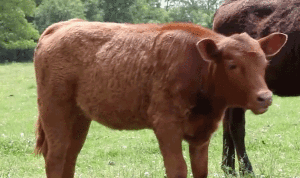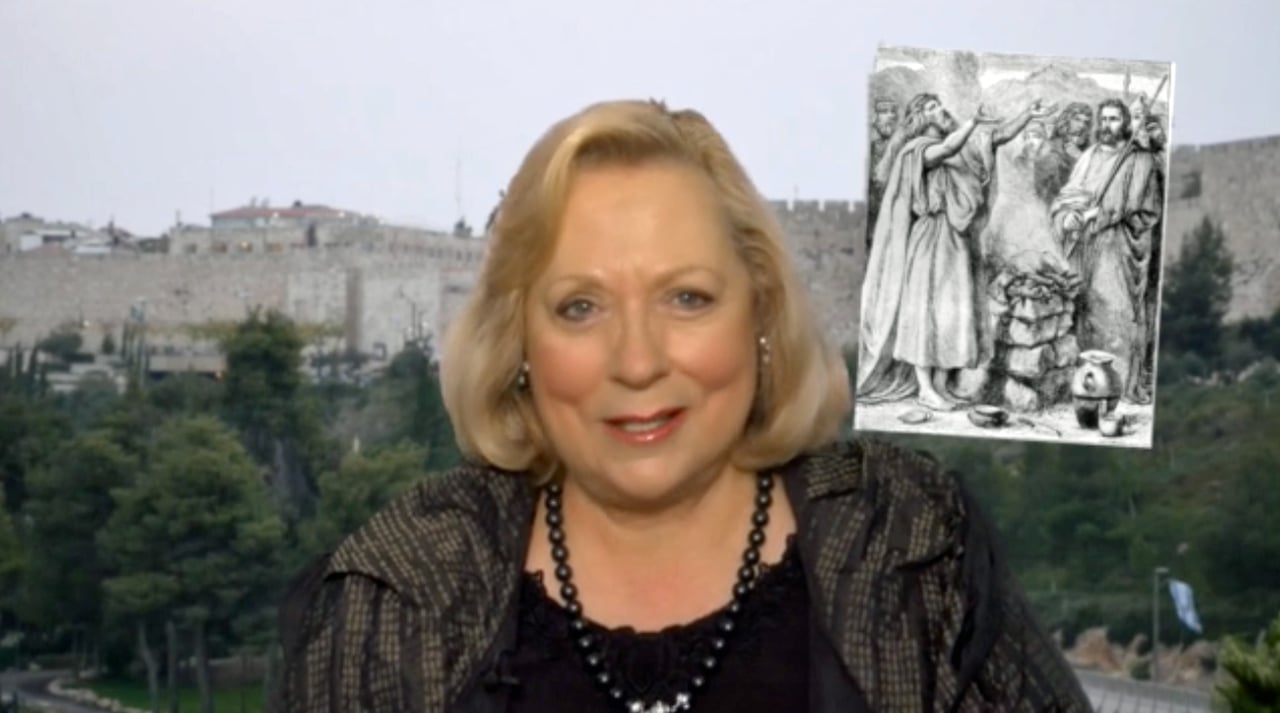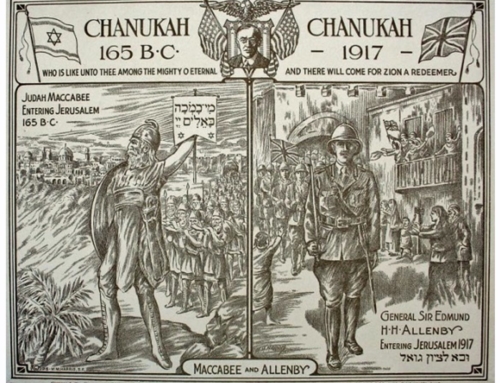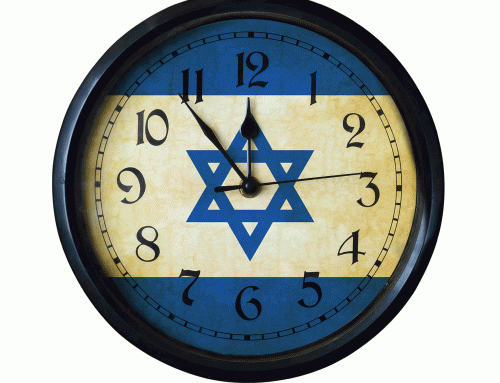The following is a transcript. To watch the video by Christine Darg, click here.
One of the great Gospel promises in the Bible is found in Isaiah 1:18, “Though your sins be as scarlet, they shall be as white as snow.” Christians see this verse fulfilled in the Atonement that Jesus secured for us on the Cross as the Lamb of God nearly 2,000 years ago. But while Christians await the promised Second Coming of Jesus, the Jews still await what they believe will be the first coming of Messiah– and interestingly the Muslims have their own version– they’re expecting a messianic leader they call the Maadi. Meanwhile, the Jewish people are preparing for the Last Days by making plans to build their Third Temple. In fact, recently the Temple Institute in Jerusalem announced their prophetic project of raising a biblically-required red cow for sacrificial Temple service in Israel. Watch this space!
 After nearly 2,000 years of mourning the destruction of the temple, according to the Temple Institute here in Jerusalem, the restoration of Biblical purity is within reach. A red heifer raised under strict rabbinical supervision will be sacrificed. But, in order for this cow to be considered kosher, it must be raised from birth in a controlled environment. The Red Angus breed has been introduced into Israel and authorized by Israel’s Ministry of Agriculture. What does all of this really mean?
After nearly 2,000 years of mourning the destruction of the temple, according to the Temple Institute here in Jerusalem, the restoration of Biblical purity is within reach. A red heifer raised under strict rabbinical supervision will be sacrificed. But, in order for this cow to be considered kosher, it must be raised from birth in a controlled environment. The Red Angus breed has been introduced into Israel and authorized by Israel’s Ministry of Agriculture. What does all of this really mean?
According to the Bible, the ashes of a sacrificial red cow are necessary for the water of purification to consecrate the temple priests and sacred vessels to be used in a future holy temple. A couple of modern candidates of red heifers have already been disqualified.
The Biblical requirement is found in Numbers 19, where God commands the children of Israel to bring a red heifer to be sacrificed. This heifer must be without spot and without blemish, and must never have been under a yoke. So the heifer, known as the “red cow,” must qualify three ways.
Number 1, it must be entirely red in color–no spots, no white or black hairs anywhere. And why red? We know that red is a symbol for blood because elsewhere in the Bible, in Leviticus 17:11, we’re told that it is blood that makes an atonement for the soul.
Secondly, (2) this red heifer must be without spot or blemish, and thirdly (3) it must never have worn a yoke—in other words it must never do any work. This speaks of the fact that we’re not saved by our works. Ephesians 2:8 is a key verse concerning salvation in the New Testament. Every believer should memorize Ephesians 2:8. It declares, “For by grace are you saved through faith; and that not of yourselves: it is the gift of God.”
Furthermore, according to Numbers 19, the heifer is to be slaughtered and burned outside the camp. The Jews have determined this was done on the Mt. of Olives. Jesus, who was the Lamb of God, also offered up his life on the cross outside the camp, outside the walls of Jerusalem.
Additionally, God specified that three prophetic items were to be added to the sacrificial fire: cedar wood, hyssop, and scarlet wool. The ashes of these four elements—the red heifer, cedar wood, hyssop and scarlet wool– were to be collected and placed in a vessel containing living spring water. Each of the elements—red heifer, cedar wood, hyssop and scarlet wool –are powerful Bible pictures of purification and atonement.
In Exodus Chapter 15, a tree, a type of the cross, was thrown by Moses into the bitter water to make it sweet for the people to drink. Cedar wood was a foreshadowing of the cross. And therefore some theologians say that based upon this Scripture in Numbers 19, allowing Scripture to interpret Scripture, the cross of Messiah was made of cedar wood!
Hyssop was used to sprinkle blood in ceremonial purifications and hyssop was the pole used to serve the sponge with vinegar for Jesus to drink during his crucifixion. Some scholars suggest the scarlet wool was a foreshadowing of the Lord’s scarlet robe. As I mentioned at the beginning of the program God declared in Isaiah 1:18, “Come now, and let us reason together: though your sins be as scarlet, they shall be as white as snow; though they be red like crimson, they shall be as wool.”
Christians believe Jesus the Messiah fulfilled all the types and shadows prefigured in the red heifer ceremony. However, even the New Testament teaches that in the last days prior to the Second Coming of Jesus, the Jews will return to their homeland and they will rebuild their temple once again. In order to proceed with rebuilding their temple, they will require the ashes of a red heifer. Is this important? Pardon the pun, but the world might think a red cow under rabbinic supervision is “udder madness.”
News pundits may miss the prophetic signifiance, but the return of the red heifer reminds us of timeless principles in holy Scripture. Primarily it teaches us the necessity for atonement beause sin has a defiling nature. The return of the red cow teaches us that the defiling power of sin is widespread in the world. The red heifer teaches us that cleansing from sin has a divine prescription and it involves a perfect sacifice without blemish and without human works. Believers in Messiah see the application in Messiah’s supreme sacrifice. Jesus, Yeshua is his Hebrew name, embraced the cross in order to expiate our sins, and He did this as One who had never worn the yoke of sin! In fact, Jesus was declared to be “without sin”; he was perfectly suitable to accomplish the glorious exploit of expiation of our sins. His disciples testified that Jesus never sinned –and even bystanders who watched Jesus die also declared that surely he was divine, the son of God.
Today, nearly 2,000 years later, the ancient ancestors of Jesus have restored the sacred temple vessels. These implements of temple worship and service are fascinating, living history, and the objects can be seen at the Temple Institute’s Visitors Center in the Jewish Quarter of Jerusalem’s Old City. We’ve taken groups there many times to see these prophetic signs and wonders. The Temple Institute stated in a recent press release that the red heifer is the Hebrew Scripture’s antidote to impurity. They recognize that we’re living in an impure world. They believe the red heifer project is imperative for the re-establishment of ritual purity.
Many Christians get angry with the Jews and say—why are they reinstituting these temple sacrifices? Christians say Biblical purity has already been acomplished through the sacrifice of the Son of God Himself. Christians believe and declare that God has already provided the perfect solution to impurity, once and for all in the sacrificial death of Jesus, the Lamb of God. Many Christians continue to ask, Why are the Jews doing this all over again? But I ask Christians to be patient with the Jews. When God outpours the spirit of grace and supplication on the House of David in the last days, as he promised to do in Zechariah 12: 10, the nation of Israel will see the pierced Messiah and mourn for him.
In the meantime, prophecies are being fulfilled according to the light and faith that the Jewish people presently have. God knows exactly where the Temple Institute is headed, and if we have the eyes of faith, we will see the bigger picture. These Orthodox Jews have been working by faith for years to honour the God of Israel by doing what they truly believe is incumbent upon them. After nearly 2,000 years of exile, they believe it is their solemn duty to rebuild God’s House.
However, the spirit of Islam is not happy with their faith efforts to transform Jewish fasting and mourning days into celebrations! Videos posted on Arabic Internet sites are shared at the Temple Institute’s website to expose Islamic apartheid and resentment against any Jewish presence on the ancient Temple Mount. Jews are not allowed to drink from a water fountain, and Muslim women hiss and taunt Jews who attempt quietly to pray on the Temple Mount. Bands of shouting veiled women swarm like hornets, hounding the Jews’ every step. Not to mention the multitude of politically correct Israeli policemen and Muslim agents who interfere to ensure that Jews don’t pray, and to immediately arrest and remove them if they do. Tragically this menacing behaviour takes place in a free and democratic Jewish state.
Despite the discouragements, Jewish visionaries are plowing ahead with plans to rebuild the temple. But there’s a dilemma facing the Jews to re-institute the red heifer sacrifice according to the prescribed methods written in the Mishna– that’s the oral traditions of the rabbis. There has been a 2000 year break since the last ashes were offered. According to Jewish tradition in the Mishnah, Moses offered the first red heifer. The ashes of that animal were mixed with a succession of eight other red heifers right through to the time of the Temple’s destruction in 70 A.D. The debate among some rabbis is that even if a perfect red heifer were found today, without the former ashes, the new ashes could not be mixed with the ancient ashes. Therefore some argue that any new Temple sacrifice wouldn’t be valid. Some believe the ashes were rescued from the Temple before its destruction and hidden away somewhere near the Dead Sea where scrolls from the Temple period were found. In fact, there have been excavations and searches by both Jewish and Christian Bible scholars and adventurers…. to try to find the ancient ashes. So far, digging in caves has produced no results, but a few men are still searching.
Without the continuity of the old ashes to mix with the new, how could Temple sacrifice be re-instated today? Well, there’s a possible footnote to the red heifer story found in the book of Judges, chapter 21. The tribes of Israel had just fought a bitter civil war. Thousands had died in battles to avenge an incident started by the belicose tribe of Benjamin. As a result, Benjamin was almost completely wiped out. Only 600 Benjaminites remained. The other 11 tribes were shocked. They cried to God, why has this happened, that there should be one tribe missing in Israel?” In the heat of battle, the men of Israel had sworn an oath not to give their daughters to Benjamin as wives. Suddenly it dawned on everyone that the remnant 600 Benjamites would die out. What a problem they’d created for themselves! They’d vowed not to give their daughters to the tribe of Benjamin. So religious leaders had to confront a seemingly insurmountable problem. The Book of Judges gives an honest account of how they overcame the deadlock. Someone noticed that a town of Israel had not sent anyone to fight in the civil war. The town was Jabesh Gilead. So they dispatched an army of warriors to kill every inhabitant of Jabesh Gilead, except for 400 young virgins who were taken to the camp at Shiloh and given as wives to the men of Benjamin. The remaining 200 eligible Benjamites took advantage of another loophole. The elders instructed the men of Benjamin to hide and watch in the vineyards, and just when the daughters of Shiloh came out to perform their dances, every man should catch a wife for himself, and if anybody complained, the people should say, we’re not guilty of breaking our oath.” And so the Benjamites caught enough wives and returned to their inheritance, and rebuilt and dwelt in their cities. So, you see, the elders managed to skirt a seemingly intractable dilemma! It wasn’t an ideal solution, but I mention this as a Biblical example of how today’s religious leaders might struggle with the missing red heifer ashes and try to find some sort of creative solution acceptable to halacha, jewish religious laws.
(By the way, it was necessary for the tribe of Benjamin to survive, however messy this Bible episode was. Without Benjamin the world would never have had King Saul, or even the apostle Paul, who was a Benjamite!) On the other hand, there may not be a dilemma after all …..if …..miraculously…. the old ashes are discovered in an archeological dig! It seems almost every day in Israel our website reports some archeological discovery!
Well, the ordinance of the ashes of the red heifer in the Bible is a fascinating study. Think about this: the ashes of the sin offering were mingled with living spring water. One of the first things to observe is the necessity of water as a purifying agent. According Numbers 19: 17, the ashes were to be put into pure spring water, and water is a symbol used in churches to this day, not only for baptisms, but in some denominations, there’s a laver of consecrated water at the door of the sanctuary. In the Old Testament the laver stood as a reminder that cleansing is necessary before approaching God. The application for believers today is that we’re forgiven through Messiah’s work on the cross; we go through the waters of baptism, and we’re washed through His Word. We need to have our minds and spirits washed daily by the reading of His Word, so we can serve and minister before Him.
The red heifer was a true type of sin offering but the heifer wasn’t slain at the temple altar, but rather outside the camp, and the carcass was wholly consumed. Theologians don’t fail to see the significance that Jesus the Messiah suffered for our sins outside the gate of Jerusalem. The ashes of this singular offering were carefully preserved to be used to communicate purifying virtue to the water. All of these details have deep meaning.
In Hebrews 9: 14, we’re told that the sin offering prefigured Messiah in his offering himself on our behalf without spot or blemish to God. Even now there’s cleansing power in the blood of Messiah. That’s why we sing the old hymn, there’s power, power wonderworking power in the precious blood of the lamb. The person who believes in Messiah is not only pardoned of sins, but our consciences are purged so we no longer shrink in shame from God, but we’re invited to draw near to his throne of grace with holy confidence. The ashes were put in the vessel of spring water and were sprinkled on an unclean person with a bunch of hyssop. What does this teach us? Sin makes us unfit for the presence of God. God provided a way to make us clean BUT we must avail oursevles of God’s provision.
As I heard Reinhard Bonnke preach so many times, a man can work in a soap factory and be surrounded by hundreds of thousands of bars of soap, but until he applies the soap to himself, he can’t get clean. Likewise….. Jesus’ blood is the cleansing agent against all sin, but by faith we must apply his blood to our sins! Here’s another deep truth: the ashes of the red heifer were used to communicate purification to water from generation to generation. This teaches us that one sacrifice was available for an indefinite number of individuals generationally. And the Good News of the Gospel is that Jesus’s sacrifice was for everybody for time and eternity, Hallelu-Yah! Anybody can avail themselves of his holy Blood… by faith! I want to magnify the great fulfillment of all of this symbolism, Jesus Himself. I must read to you the commentary of Hebrews 9:13-14. This says it all! “Under the old system, the blood of goats and bulls and the ashes of a heifer could cleanse people’s bodies from ceremonial impurity. Just think how much more the blood of Christ will purify our consciences from sinful deeds so that we can worship the living God. For by the power of the eternal Spirit, Christ offered himself to God as a perfect sacrifice for our sins.” You see, there’s no comparison between the blood of Messiah and bulls, goats and red cows. They were only symbols; the animals weren’t conscious of bearing iniquity. Messiah was fully conscious. Jesus knew exactly what he was doing. He was continually led by the Holy Spirit, and He was moved by the Holy Spirit to offer up his life as a sacrifice for sin. And what remains of Him? Not ashes, but a resurrected body who’ll never die again. He ever lives to make intercession for us. The red heifer was intended to cleanse from ceremonial defilement. But how much more shall the blood of Messiah cleanse us from ALL sin? …..
Well, sadly, we’re informed in the New Testament that the man of sin known elsewhere in the Bible as the Anti-Christ will defile the Third Temple and declare himself to be God. When this happens, the Jewish people will know they’ve been betrayed and defiled. The fact that the Jewish people are determined to build their Third Temple indicates we’re living in the End-Times. So how can you be sure you’re ready for the coming of the Lord? You may rejoice that your sins have been atoned for by the spotless Lamb of God. His sacrifice on the Cross is efficacious for time and eternity for anybody who chooses to put their trust in Him. The Blood of Messiah is a zillion times more effacious that the ashes of the red heifer. You can have your sins covered through genuine repentance and asking the Lord to forgive you and to wash you with his atoning blood. Do you recall in John Chapter 3 when Jesus taught Nicodemus, a rabbi and member of the sandrerin, that a person must be born again? Nicodemus was surprised by that statement, but Jesus rebuked him. Jesus said a teacher in Israel should know that the Hebrew Scriptures teach beign born again. In fact, King David prayed in Psalm 51: 7, “purge me with hyssop and I shall be clean: wash me, and I shall be whiter than snow.” Sin is contagious. All people on the planet are infected with it. The blood of Messiah is of sufficient value to cleanse us from all sin and to present us white as snow. But, to enjoy its benefit, the blood must be applied by faith. Wherever the Lord’s blood is applied, its power takes effect immediately.
I hope today will be the day of your eternal salvation! Believe and confess with me, Heavenly father, thank you that the blood of Messiah is more powerful that the blood of goats and the ashes of a red heifer. Thank you that Jesus died to pay for my sins. Thank you that he took all of my sins to the grave. I choose to put my eternal trust in him. Thank you that there’s power, wonderworking power in the precious blood of the Lamb! Amen! Well, we’re out of time but you can watch this program again or any of our programs anytime at our website at exploits.tv where you can click online to receive our newsletters and updates about our prayer convocations in Israel. Until next time, earnestly contending for the faith, watching on the walls, and praying for the peace of Jerusalem, I’m Christine Darg, shalom!







Leave A Comment